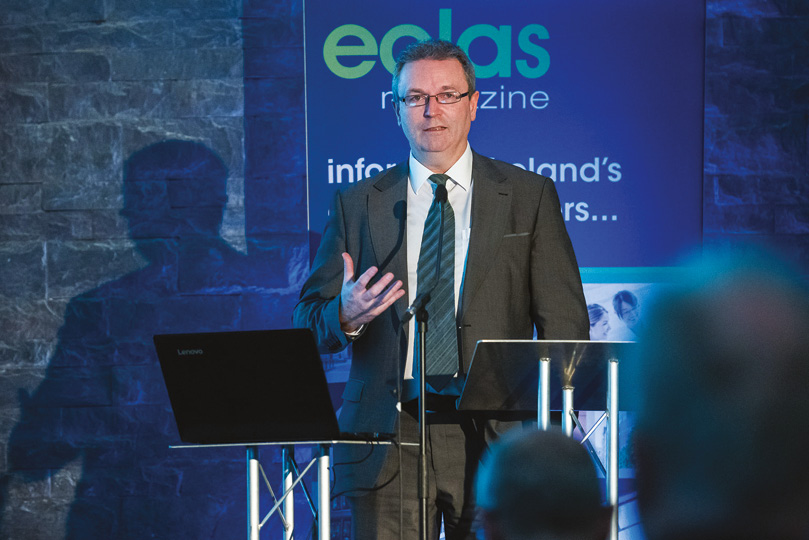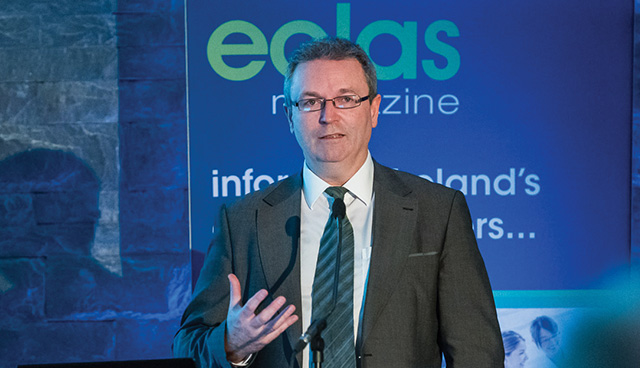National Planning Framework: the big picture


David Walsh, Assistant Secretary at the Department of Housing, Planning and Local Government addresses the 2018 Planning Conference, contextualising the National Planning framework (NPF) and summarising the high-level priorities for development.
As Assistant Secretary for the Planning, Land Management and Housing Market Policy Division in the Department, Walsh has been working on the NPF and its predecessor, the National Spatial Strategy (NSS) for the last 12 years.
There is, he explains, a very strong link between the NPF and the capital investment programme, the National Development Plan. “The purpose of Project Ireland 2040 is to integrate, for the first time, the spatial plan for Ireland over the next 20 plus years, and an investment strategy. It mirrors the planning with the investment as way to demonstrate to our citizens, as well as to the wider business sector that we have a vision, we know where we want to go, and we have a plan and some sense of how to get there.”
Outlining what the NPF is and what it isn’t, Walsh seeks to dispel ‘myths’. The NPF, he emphasises, is a flexible framework document, not a blueprint. “We know that our vision and plan for 2040 will more than likely not be what the end product looks like. But the point is, over the next five, 10 and indeed 20 years, it has to adapt, learn and ensure that it remains current in a changing national and regional circumstance.”
As a ‘big picture’ document, the NPF does not have the level of detail which will be seen in the regional spatial economic strategies which will flow from it. What the NPF does not represent is equally as important.
“It’s not a labelling or a naming exercise. In the NSS we had ‘gateways’ and ‘hubs’ which, outside of the system, were very much regarded as a designation. Rather than designations, the NPF is about each region and local area identifying the priorities for progression and development within their remit. We aren’t looking to restrict regional or rural ambition, it’s about managing change to achieve new goals and ensuring that we maximise the opportunities.”
The regions
The NPF is intended to act as the central document around which the three regional assemblies will coordinate and will ultimately be reflected through specific actions in the city and county development plans. Indeed, the regional assemblies have already undertaken work to consolidate the NPF principles and priorities in their respective contexts. This has been augmented through the recognition of regional towns which play city-like role within their local context and an acknowledgment of the importance of cross-border relationships.
The final draft of the NPF also contains a significant focus on regional jobs growth. “While the evidence suggests that there was much population growth in towns and satellite towns around the major cities, it wasn’t matched with jobs growth. This imbalance is particularly evident in the increase of commuter-driven development.
“The €116 billion of capital investment in the NDP will help to plan and invest more strategically and over longer time-horizons. All of our previous investment programmes have been one year, three years or maybe five years at a push, but many of the major projects and investments that we require at regional and city level are really 10-year-plus projects. Having that level of certainty around major investment and the programmes to tie them back to planning principals is certainly a game-changer from my own Department’s perspective,” Walsh outlines.
Dublin
The NPF acknowledges Dublin’s status as the country’s primary city of scale and the principal economic driver. “We have to make sure that Dublin maintains its national role and recognise that it is competing with European cities rather than our regional cities,” emphasises the Assistant secretary. “In order for Dublin to continue to grow and to flourish, we do need to better manage future development, bringing more housing back into the city itself, creating more compact growth, and investing in the modern and future-proofed infrastructure that all cities like Dublin will need.
“The key thing will be better design, but also recognising that the city must change. We expect that a quarter of the increase in population will actually happen in Dublin and therefore we must disrupt the current, unsustainable patterns. This means taller buildings, better public spaces and better amenities for those who work in the city itself.”
Opportunities identified in the framework to renew and enhance core city centre areas, and areas within the M50, which are well served by transport, water and services, but are possibly no longer delivering their full purpose or potential, will require a concerted effort by the wider public agencies as well as the private sector, working closely together.
Second-tier cities
Significant growth is also targeted for Cork, Galway, Waterford and Limerick, cities which have grown by less than 25 per cent over the last 20 years. “They need to double that and grow at a minimum of half again according to their respective numbers,” asserts Walsh. “If you were to divide the projected growth of one million people; one quarter will be targeted for Dublin, another quarter for growth in the four other cities, with the balance spread across the regions in larger settlements, smaller towns and rural areas.
“The key thing will be better design, but also recognising that the city must change… This means taller buildings, better public spaces and better amenities for those who work in the city itself.”
“Just like in Dublin, there are major opportunities to reuse and redevelop some major sites. In Galway you have the port and the rail station, in Waterford there are plans for the North Quays as part of the SDZ already designated there, Limerick city centre and the Georgian Quarter, then in Cork there are opportunities in the docklands and indeed the rail station. A lot of those key sites have the potential to change the fabric of the urban city.”
The NPF sets a target of 40 per cent of new development to happen within or very close to the existing footprints of the five cities. As many of these sites are State-controlled, Government departments, local authorities and agencies must be driving and pushing for better utilisation.
Rural Ireland
From the analysis underpinning the preparation of the Framework, there is very clear evidence of population decline outside areas of urban settlement. This, the Planning Department representative states, must be reversed and the narrative of Ireland’s rural towns and villages transformed. Acknowledging that the €1 billion Rural Regeneration Fund, managed by Minister Michael Ring and his department, “won’t solve all the problems”, Walsh maintains that, together with a €2 billion fund for urban regeneration, it will provide a very good opportunity to develop new systems which will transform these towns and villages.
“Proper planning and planning-led development, which we all strive towards as professionals, will simultaneously protect the countryside as well as deliver necessary services, enabling those who are working and living rurally to continue to do so. Local authorities will obviously have a very important role here, particularly in the context of managing and investing in the rural areas. While we haven’t hugely altered rural housing policies in the NPF, that is a piece of work which is being considered in the context of the new Sustainable Rural Housing Guidlines. We do need to ensure that there are opportunities for people to live and work in a rural setting and how to manage and deliver that while protecting towns and villages which are being denuded,” he says.
In a very changing economic environment, where digital connectivity, opportunities to work from home, microenterprises, there is a huge opportunity to harness potential in the rural context.
Implementation
The challenge now is implementation. After three years working to get the NPF over the line, minds are now turning to how this will work in practice and make the difference it is designed to do. “There are regional and local processes to follow, but equally we have to ensure that there is enough monitoring, coherence and coordination, not only from ourselves in the Department, but also in DPER through NDP investments,” outlines Walsh.
“The NPF has now supplanted NSS references in the Planning Acts. It is clearly at the top of the planning hierarchy and must be taken account of in terms of regional planning, local planning and decision-making by authorities and An Bord Pleanála. However, we need to further strengthen the links between all scales of planning to demonstrate the coherence and consistency that will deliver a better planned future.”
As recommended in the Mahon Tribunal Final Report a new Office of the Planning Regulator is to be established, with legislation which is currently in the Seanad giving effect to that. As an independent office, it will provide a level of oversight and possible enforcement of issues. “We have to ensure that the relevant policies and actions are aligned from national, to regional, to local level and that is our next priority,” concludes Walsh.





